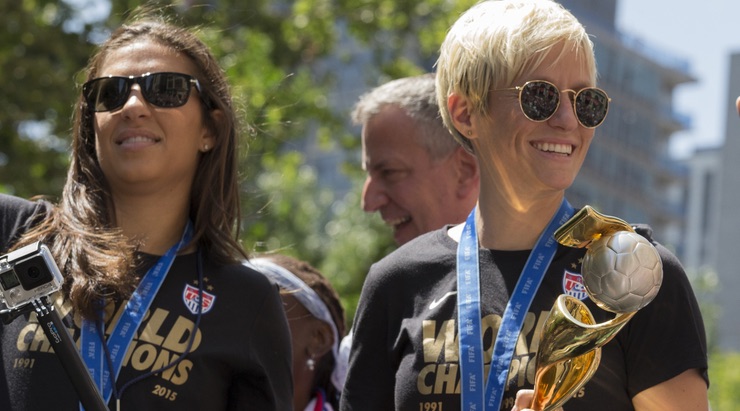The War of Gender Equality and Equal Pay
Days after Carli Lloyd, Alex Morgan and Hope Solo accuse U.S. Soccer of wage discrimination we celebrate Equal Pay Day… and wonder what we have to do to finally achieve parity among the sexes and end the gender pay gap. From smiling in the picture above during the NYC victory parade to filing suit…
While I do not know how many of us woke up knowing that Tuesday, April 12, 2016 commemorates the pay gap between women and men, most of knew Hope Solo, Alex Morgan, Carli Lloyd, Becky Sauerbrunn and Megan Rapinoe accused U.S. Soccer of wage discrimination. When these five female players of the U.S. Women’s National team filed on March 30th a wage-discrimination action with the Equal Employment Opportunity Commission (EEOC) against the U.S. Soccer Federation – headlines around the country lit up.
The timing was certainly explosive. Although the issues are complex, the headlines have been simple and the outcry of support from fans and professional athletes have been fabulous.

According to National Committee on Pay Equity (NCPE) who kicked off Equal Pay Day in 1996, Equal Pay Day always falls on a Tuesday — picked to illustrate how far into the next work week women must work to earn what men earned the previous week. (Read that again.) While this mathematical formula may not be exactly correct when calculating the pay for our female soccer players who won the 2015 FIFA Women’s World Cup — it clearly points out a huge problem.
As a thriving force of financial gain, our women’s team deserve to share the spoils of victory independent of their DNA. Winning the Women’s World Cup created longstanding financial benefits for U.S. Soccer – $20 million in revenues for U.S. Soccer according to a recently released annual financial report.
The war on equal pay is reminiscent of the battle fought by Suffragettes — and, how many of us question a women’s right to vote or could imagine an election in which only men were allowed to cast their opinions? The question is not why but when women will be paid equally for the same job.
U.S. Soccer rules the game of soccer in our country and is the ‘boss’ of the players on the U.S. National Team. While the Head Coach of the Men’s National Team, Jurgen Klinsmann, may be fighting an uphill battle to improve his team’s mediocre performance on the world stage, our women’s team has won the World Cup 3 times.
And they are tired of being paid less than men.

According to the New York Times, “The numbers speak for themselves,” said goalkeeper Solo, one of the players to sign the complaint. “We are the best in the world, have three World Cup championships and four Olympic championships.” Solo said of the men’s players, “they get paid more to just show up, than we get paid to win major championships.”
According to research, U.S. Soccer pays women a smaller per diem, a lower appearance fee, less per game played and a skewed pay structure of bonuses. Clearly, the DNA of a man is rewarded with better financial payments. All of this is detailed in the Federal complaint submitted to the Equal Employment Opportunity Commission:
While it may be disconcerting that U.S. Soccer’s reported payments to men are $3,750 for a public appearance and only $3,000 to a female player – the consistent discrimination is horrifying.
U.S. Soccer has been very supportive of the women’s game and has helped the National Women’s Soccer League (NWSL) — the nation’s top women’s professional soccer league — survive to its fourth season. U.S. Soccer’s president, Sunil Gulati, is a Senior Lecturer of Economics at Columbia University in NYC and does not appear in any way to be an impervious chauvinist wanting to oppress women. A sophisticated man who has successfully negotiated the wreckage of FIFA, Gulati seems to be caught, almost blindsighted, by the women players he is so proud of.
While the figures recapping pay in the complaint against U.S. Soccer may be reflecting only one side of the argument and not represent the whole financial picture, no one seems to be arguing that our women soccer players are paid equally or even properly. Nor does anyone argue that women in the general workforce are paid fairly.
Undaunted by what may happen in the court room, the U.S. Women’s Team scored big on the field defeating Columbia 7-0 last Wednesday surrounded by nearly 22,000 cheering fans.
With the Olympics looming in the near future, many people are skeptical of the timing of this action – yet the catalyst may not be the timing of any collective bargaining agreement as much as the forces of nature which have been gathering force for decades.
 The National Women’s Law Center released information last week showing that the wage gap costs women $430,480 over a 40-year. For Latinas, this lifetime wage gap totals $1,007,080, and for African American women, the losses are $877,480.
The National Women’s Law Center released information last week showing that the wage gap costs women $430,480 over a 40-year. For Latinas, this lifetime wage gap totals $1,007,080, and for African American women, the losses are $877,480.
Sad – and shocking.
The new analysis features an interactive map and state-by-state rankings of the lifetime wage gap for women overall and women by race and ethnicity. “Women shouldn’t have to work nearly 51 years to make what a man makes in 40 years,” said Emily Martin, NWLC General Counsel and Vice President for Workplace Justice. “The wage gap hasn’t budged in nearly a decade, and as a result women are losing hundreds of thousands of dollars during their work years. And for many women of color, the cost of the lifetime wage gap will exceed a million dollars. We literally can’t afford to ignore this.”
While Crystal Dunn, Julie Johnston, Christen Press, Heather O’Reilly, Ali Krieger, Allie Long, Lindsey Horan, new comer Mallory Pugh and other members of the U.S. Women’s National team roster are not throwing all their weight in yet, women around the world are looking and watching – what will happen? The questions on everyone’s mind – if you reach the pinnacle of your profession and are celebrated around the world as the best – is equal pay still further down the horizon? Is all that achievement still not enough to get paid the same as a man?
Related Article on NY Times: Carli Lloyd: Why I’m Fighting for Equal Pay
Wonder what the consequences are for women, their families and the country’s economy? Check out the Joint Economic Committee United States Congress April 2016 report on gender-pay-inequality – the bottom line is a woman working full time earns $10,800 less per year than a man – adding up to nearly half a million dollars over a career. At the older ages, research shows women are paid 44% less than their male counterparts – a staggering difference.
Women must ask for fairness. At least our women who have won the World Cup are taking to the courts to fight for equal pay. We can thank these women for being our advocates for equality along with being the best women in soccer.
The question is: What are you doing to help end this embarrassing discrimination?
If everyone helps, we can make this a day celebrating fairness and move towards a time when people barely remember when being a women allowed someone to pay her less than a man for the same work. After all, we have Hillary Clinton running for president and back when women didn’t have the right to vote, that would have seemed close to impossible. Make 2016 Equal Pay Day count – We owe it to our future generations.






